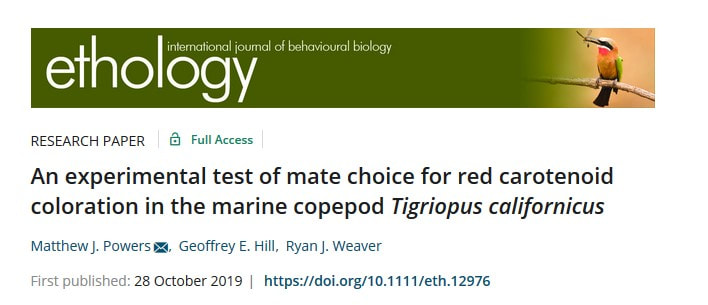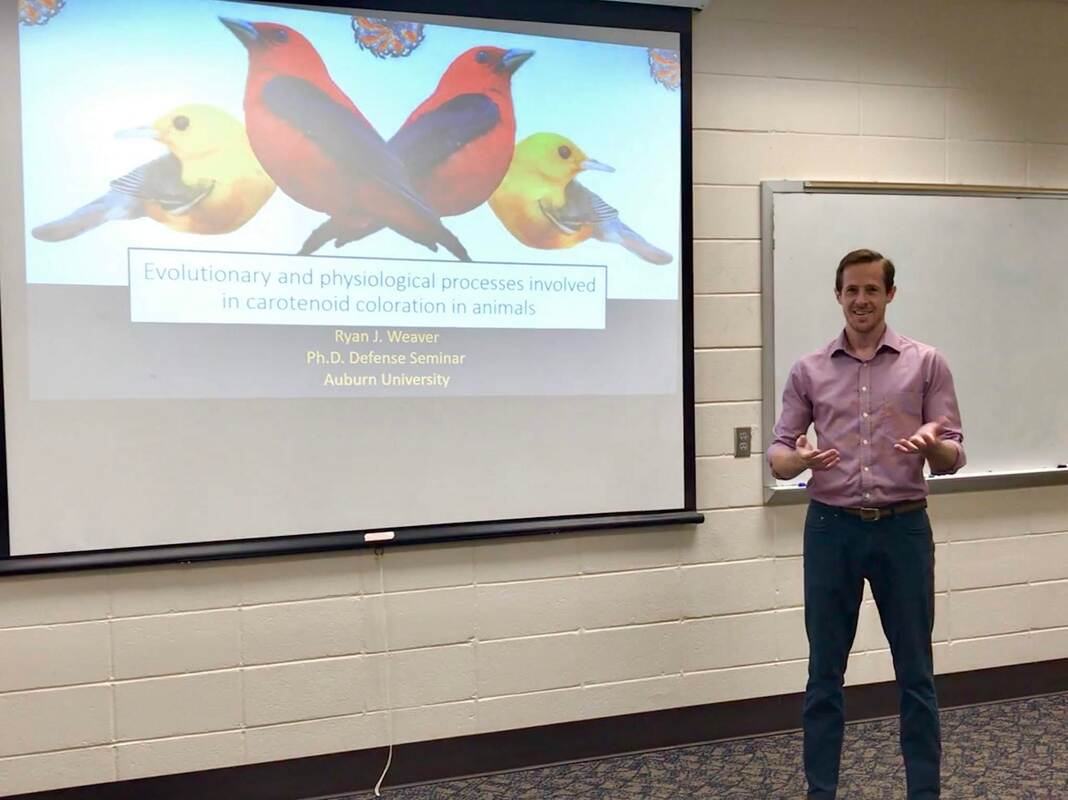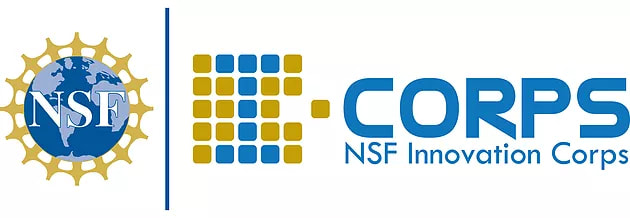|
I officially joined the Department of Ecology, Evolution, and Organimsal Biology and the Department of Natural Resource Ecology and Management at Iowa State University on August 16th 2021 as an Adjunct Assistant Professor. I've been delighted to meet a wonderful group of colleagues and I look forward to setting up my lab to resume research on mitochondrial physiology, mitonuclear co-evolution, and other topics in evolutionary biology.
1 Comment
Our latest paper on Tigriopus caroteniod coloration has been accepted at Ethology! These copepods are chock-full of red carotenoids, but some individuals are less colorful than others. Previously we've shown that carotenoids do provide protection against an oxidative challenge, most likely by functioning as an antioxidant. This led us to wonder if carotenoid coloration was under sexual selection via mate choice, as it is in birds and other vertebrates. Here is a link to the paper We found that after controlling for some confounding variables (sexual chemical cues on the surface of the exoskeleton), carotenoid coloration alone was not used as a criterion in mate choice.
As we dig deeper into the ways animals use carotenoids, it is clear that they are serving multiple roles that seem to be taxon specific. Some vertebrates have clearly co-opted carotenoids for colorful ornaments assessed during mate choice or intraspecific competition, while the relevant role for carotenoids as antioxidants appears to be limited, at least in birds. We and others have found the opposite in crustaceans. What remains to be discovered is how functional differences in carotenoid use among taxa are linked to differences in the genetics and biochemistry of carotenoid metabolism (e.g., uptake, bioconversion, cleavage).  I gave a 5-minute lightning talk at the American Ornithological Society's annual meeting in Anchorage, Alaska. I'm always trying to find ways to keep my foot in the bird research world, and luckily I had some cool results to present from a project with my former labmate, Nick Justyn at Auburn University. As usual, the meeting was full of great talks on excellent science, and exploring the surrounding area resulted in views of amazing animals and landscapes. I have one more bird-related project up my sleeve, but after that, I'm not sure when I'll be back to AOS :( Painting the Bunting: The molecular and structural basis for coloration of male Painted Buntings
I was awarded an NSF Postdoctoral Fellowship in Biology, which will provide support for me to investigate the roles of AOX in facultative sex and help me broaden participation of first-generation college students in scientific research.
This is my 4th award from NSF: EAPSI, ICORPS, DDIG, PRFB An increasing number of universities are recognizing the poor predictive power and socio-economic biases associated with standardized test scores. As a result, some universities no longer require the Graduate Record Examinations (GRE) test or use applicants' scores as a criterion for acceptance to graduate school. This is a great step forward, but brings about some potential problems; other metrics, such as research experience and related letters of recommendation will likely carry more weight (as I think they should). The problem is that access to research experience suffers from the same biases as standardized tests. Often, NSF-funded Research Experiences for Undergraduates (REU) programs and individual PIs use grade point averages (GPA) as a filter when selecting potential undergraduate trainees. Unfortunately, this criterion also is biased against certain populations, including first-generation college students. My goal is help break down barriers to science education and research experience by recruiting students for research training by evaluating personal interest, curiosity, and creativity, and not GPA. One thing I've learned is that our past performance doesn't dictate our future or our capacity to learn. Any opinions, findings, and conclusions or recommendations expressed in this material are those of the author(s) and do not necessarily reflect the views of the NSF. My latest paper and my first solo-authored (!) paper is now available online. I propose some evolutionary consequences of a lesser-known component of animals mitochondria, the alternative oxidase (AOX). This paper is a synthesis of my thoughts on stress, sex, and species ID problems that have been swirling around in my head for the past few years. I outline some ways to test the hypotheses I put forward and am working on those experiments currently. I'm excited to see where these ideas lead my research, and perhaps others' in the mitochondrial research field. Here is a link to the paper
I had a great time at the meeting, catching up with colleagues and hearing about some awesome science, especially in the mitonuclear field. I gave a talk in the complimentary session to the Mitonuclear Symposium where I compared the effects of hybridization on carotenoid metabolism in highly diverged and shallowly diverged taxa.
Our latest paper on the physiological roles of carotenoids in Tigriopus californicus copepods. Here is a link to the paper We found that the red carotenoid, astaxanthin is not only responsible for its coloration, but also provides protection from an oxidative challenge.
I was honored to be invited to give a talk at the Gordon Research Seminar on Carotenoids this summer. As one of 10 speakers from fields ranging from plant physiology, human nutrition, aquaculture, and biology, I added an evolutionary perspective on the role of carotenoids in animals by discussing their use as pigments of sexually selected ornaments.
This seminar series is unique in that it provides an opportunity to network with other early career researchers from fields of study that I may not otherwise encounter at the conferences I typically attend. I am thankful for the opportunity to share my research. It was a great meeting with new ideas and perspectives from diverse fields of carotenoid research! My second paper of the year and 5th total. This time, back to my roots, birds, with a meta-analysis that shows carotenoid-based feather coloration is an honest signal of some, but not all measures of quality. For birds to display yellow or red feather coloration, they must first eat food that contains pigments called carotenoids. But birds mostly eat yellow carotenoids. To produce red feathers, birds must first convert the yellow pigments to red. The importance of this conversion step in linking color to quality has not previously been investigated. Here is a link to the paper We found that, after controlling for several potentially confounding factors, it looks like carotenoid conversion helps to make the link between feather coloration and individual quality stronger. These results should help future studies to focus on the specific mechanisms that link carotenoid conversion to a strong signal of individual quality in birds and other animals.
Starting the new year off right with a publication in the Journal of Plankton Research on the bioconversion of dietary carotenoids to astaxanthin by Tigriopus californicus. And we got the cover! A first for me You can access there paper here
Here is a link to the paper We review the most widely cited mechanism that is based on costly resource-tradeoffs and propose an alternative cost-free mechanism that has been used to explain vocal and behavioral displays, but not for coloration. We call it the shared pathway hypothesis.
When I began grad school, I told myself I would pursue any and all opportunities to learn new skills that I thought might help create more career options. In January 2017, that instructive led me into the world of entrepreneurial training through the NSF I-Corps program, a competitive award that provides training in how to turn scientific discoveries into viable business opportunities. I was the Entrepreneurial Lead of the team along with Geoff Hill as PI and Lew Scharpf as the Industry Mentor. We were focused on the farm-raised fish industry, where we thought we could provide a novel natural source of the red pigments used to make fish like salmon and trout their characteristic color. Synthetic sources of this pigment are cheap and readily available, but recent market pressures for natural sources of red pigment are increasing each year. To summarize the program with one word it would be: INTENSE. Unlike traditional business development strategies where you build a product, raise money, start a company, then find customers, the I-Corps program adopts the lean business model canvas system where the first step is to figure out if you've developed a product that people actually want to buy! The main task of this program was to conduct 'Customer Discovery Interviews' to address just that question by learning about the industry and the needs of your potential customers. In 7 weeks I traveled across the United States to conduct these interviews in-person. In the end we learned that there was a need for our product, but that producing enough of the product to meet industry demands was a major hurdle to enter the market.
I am beyond excited to announce that I was awarded the NSF Doctoral Dissertation Improvement Grant! This is the 3rd NSF award I have won (EAPSI and I-Corps previously) and am grateful for the opportunity to conduct great research with the support of this critical program. Here's an overview of what I proposed:
|
























 RSS Feed
RSS Feed
